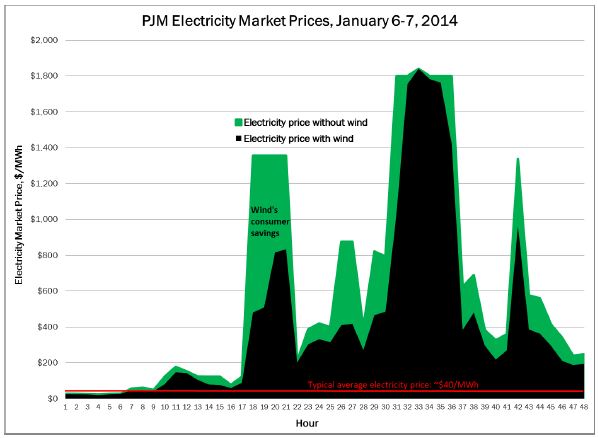Cold weather has returned to much of the United States, and the wind energy industry is pivoting off the big chill to tout their turbines’ ability to provide cheap electricity when fuel prices for other sources skyrocket.
The American Wind Energy Association said Wednesday that new research shows during last year’s dramatic January icy spell, wind energy saved consumers $1 billion in the PJM Interconnection. PJM is the grid operator for all or parts of Delaware, Illinois, Indiana, Kentucky, Maryland, Michigan, New Jersey, North Carolina, Ohio, Pennsylvania, Tennessee, Virginia, West Virginia and the District of Columbia – serving some 61 million people.
AWEA came up with its big shiny savings number after analyzing hourly grid data during the event of January 6-7, 2014, peering down to the power plant level, it said, and estimating the price of electricity without wind and comparing it to the price with wind. “The difference in prices between the wind and no-wind cases, multiplied by the total demand in that hour and summed for all hours, is the consumer price reduction benefit provided by wind,” the group said.
The cool billion in savings reduced the total cost of wholesale PJM power by 27 percent during the period, AWEA said.
The “polar vortex” presented one of the more dramatic grid challenges in recent years. According to the Energy Research Council, “eight of the 10 highest winter demand levels for electricity ever recorded by PJM occurred in January 2014.” And as demand was rising, supply from traditional sources was often imperiled. “Cold weather burdened all types of power generation, including gas, coal, and nuclear power plants,” the ERC said. “Some generators experienced extended run times, resulting in unplanned shutdowns.”
AWEA’s research director, Michael Goggin, said in a media briefing that wind turbines weren’t completely invulnerable to the cold, but with most turbines able to operate even when temperatures fall to the zero mark, they did better overall than the frequently failing thermal generators.
And the price of the fuel – the wind – remained at zero, as it always does.
“Wind energy creates … large consumer benefits by displacing the most expensive, least efficient, and most volatilely-priced power plants with a fixed-priced, zero-fuel-cost, zero-emission energy source,” Goggin and colleague Greg Hresko said in the newly released report.
But not everyone was buying what AWEA was selling. James M. Taylor, senior fellow for environment and energy policy at the Heartland Institute, said in an interview that he hadn’t had a chance to look over the AWEA report, but added that even if the group’s analysis was correct, it was mere “cherry-picking” that masked wind’s overall high cost to consumers.
“Natural gas spiked for a two-day period and perhaps for that two-day period, wind energy was less expensive,” Taylor said. “But I don’t think very many consumers are going to think it’s a good idea to pay more for their electricity for 363 days of the year in order to save a little bit during a two-day period.”
Taylor has argued that in the states with the most wind power as a percentage of generation, the average price of electricity went up at least 20 percent during the 2008-2013 period, during which the nationwide average was up just 3 percent. (In that instance, AWEA made its own accusation of cherry-picking, chiding Taylor for leaving out Texas, No. 11 in wind generation as a percentage of total generation and a state where energy prices declined slightly.)
But back to wind and the cold: “You can get wind on very cold days. There are also very cold days that have very little wind,” Taylor said in our telephone interview. “That’s wind, you just don’t know.”
This year as in last year, however, wind was coming through during one of the coldest spells, and AWEA was all over the opportunity. “Wind is making a major contribution in a lot of regions today, keeping prices low,” Goggin said. In the Southwest Power Pool in the lower plains states, for instance, wind was humming along at 7,000 MW of output, he said.

